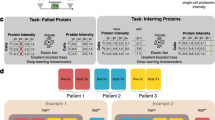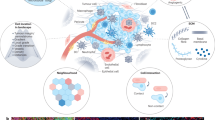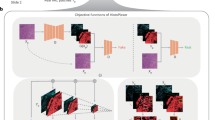Abstract
Understanding tissue structure and function requires tools that quantify the expression of multiple proteins at single-cell resolution while preserving spatial information. Current imaging technologies use a separate channel for each protein, limiting throughput and scalability. Here, we present combinatorial multiplexing (CombPlex), a combinatorial staining platform coupled with an algorithmic framework to exponentially increase the number of measured proteins. Every protein can be imaged in several channels and every channel contains agglomerated images of several proteins. These combinatorically compressed images are then decompressed to individual protein images using deep learning. We achieve accurate reconstruction when compressing the stains of 22 proteins to five imaging channels. We demonstrate the approach both in fluorescence microscopy and in mass-based imaging and show successful application across multiple tissues and cancer types. CombPlex can escalate the number of proteins measured by any imaging modality, without the need for specialized instrumentation.
This is a preview of subscription content, access via your institution
Access options
Access Nature and 54 other Nature Portfolio journals
Get Nature+, our best-value online-access subscription
$32.99 / 30 days
cancel any time
Subscribe to this journal
Receive 12 print issues and online access
$259.00 per year
only $21.58 per issue
Buy this article
- Purchase on SpringerLink
- Instant access to full article PDF
Prices may be subject to local taxes which are calculated during checkout






Similar content being viewed by others
Data availability
Experimental data can be found on the BioImage Archive (https://www.ebi.ac.uk/biostudies/studies/S-BIAD873). A list of reagents and instruments can be found in Supplementary Table 1 under ‘key resources’.
Code availability
The code for CombPlex can be found on GitHub (https://github.com/KerenLab/CombPlex).
References
Rodriguez-Canales, J., Eberle, F. C., Jaffe, E. S. & Emmert-Buck, M. R. Why is it crucial to reintegrate pathology into cancer research? Bioessays 33, 490–498 (2011).
Odell, I. D. & Cook, D. Immunofluorescence techniques. J Invest. Dermatol. 133, e4 (2013).
Tsujikawa, T. et al. Quantitative multiplex immunohistochemistry reveals myeloid-inflamed tumor-immune complexity associated with poor prognosis. Cell Rep. 19, 203–217 (2017).
Gerdes, M. J. et al. Highly multiplexed single-cell analysis of formalin-fixed, paraffin-embedded cancer tissue. Proc. Natl Acad. Sci. USA 110, 11982–11987 (2013).
Radtke, A. J. et al. IBEX: a versatile multiplex optical imaging approach for deep phenotyping and spatial analysis of cells in complex tissues. Proc. Natl Acad. Sci. USA 117, 33455–33465 (2020).
Schubert, W. et al. Analyzing proteome topology and function by automated multidimensional fluorescence microscopy. Nat. Biotechnol. 24, 1270–1278 (2006).
Lin, J. R. et al. Highly multiplexed immunofluorescence imaging of human tissues and tumors using t-CyCIF and conventional optical microscopes. eLife 7, e31657 (2018).
Kinkhabwala, A. et al. MACSima imaging cyclic staining (MICS) technology reveals combinatorial target pairs for CAR T cell treatment of solid tumors. Sci. Rep. 12, 1–16 (2022).
Gut, G., Herrmann, M. D. & Pelkmans, L. Multiplexed protein maps link subcellular organization to cellular states. Science 361, eaar7042 (2018).
Goltsev, Y. et al. Deep profiling of mouse splenic architecture with CODEX multiplexed imaging. Cell 174, 968–981 (2018).
Wang, Y. et al. Rapid sequential in situ multiplexing with DNA exchange imaging in neuronal cells and tissues. Nano Lett. 17, 6131–6139 (2017).
Saka, S. K. et al. Immuno-SABER enables highly multiplexed and amplified protein imaging in tissues. Nat. Biotechnol. 37, 1080–1090 (2019).
Lin, R. et al. A hybridization-chain-reaction-based method for amplifying immunosignals. Nat. Methods 15, 275–278 (2018).
Stack, E. C., Wang, C., Roman, K. A. & Hoyt, C. C. Multiplexed immunohistochemistry, imaging, and quantitation: a review, with an assessment of tyramide signal amplification, multispectral imaging and multiplex analysis. Methods 70, 46–58 (2014).
Keren, L. et al. MIBI-TOF: a multiplexed imaging platform relates cellular phenotypes and tissue structure. Sci. Adv. 5, eaax5851 (2019).
Giesen, C. et al. Highly multiplexed imaging of tumor tissues with subcellular resolution by mass cytometry. Nat. Methods 11, 417–422 (2014).
de Souza, N., Zhao, S. & Bodenmiller, B.Multiplex protein imaging in tumour biology. Nat. Rev. Cancer 24, 171–191 (2024).
Zidane, M. et al. A review on deep learning applications in highly multiplexed tissue imaging data analysis. Front. Bioinform. 3, 1159381 (2023).
Elhanani, O., Ben-Uri, R. & Keren, L. Spatial profiling technologies illuminate the tumor microenvironment. Cancer Cell 41, 404–420 (2023).
Moffitt, J. R., Lundberg, E. & Heyn, H. The emerging landscape of spatial profiling technologies. Nat. Rev. Genet. 23, 741–759 (2022).
Chen, K. H., Boettiger, A. N., Moffitt, J. R., Wang, S. & Zhuang, X. Spatially resolved, highly multiplexed RNA profiling in single cells. Science 348, aaa6090 (2015).
Eng, C. H. L. et al. Transcriptome-scale super-resolved imaging in tissues by RNA seqFISH. Nature 568, 235–239 (2019).
Milo, R., Jorgensen, P., Moran, U., Weber, G. & Springer, M. BioNumbers—the database of key numbers in molecular and cell biology. Nucleic Acids Res. 38, D750–D753 (2010).
Campagne, F., Dorff, K. C., Chambwe, N., Robinson, J. T. & Mesirov, J. P. Compression of structured high-throughput sequencing data. PLoS ONE 8, 79871 (2013).
Cleary, B., Cong, L., Cheung, A., Lander, E. S. & Regev, A. Efficient generation of transcriptomic profiles by random composite measurements. Cell 171, 1424–1436 (2017).
Cleary, B. et al. Compressed sensing for highly efficient imaging transcriptomics. Nat. Biotechnol. 39, 936–942 (2021).
Sachs, K. et al. Compressed sensing for simultaneous measurement of multiple different biological molecule types in a sample. JUSTIA Patent 10832795 (2013).
Schürch, C. M. et al. Coordinated cellular neighborhoods orchestrate antitumoral immunity at the colorectal cancer invasive front. Cell 182, 1341–1359 (2020).
Keren, L. et al. A structured tumor-immune microenvironment in triple negative breast cancer revealed by multiplexed ion beam imaging. Cell 174, 1373–1387 (2018).
Greenwald, N. F. et al. Whole-cell segmentation of tissue images with human-level performance using large-scale data annotation and deep learning. Nat. Biotechnol. 40, 555–565 (2022).
Bai, Y. et al. Expanded vacuum-stable gels for multiplexed high-resolution spatial histopathology. Nat. Commun. 14, 1–18 (2023).
HuBMAP Consortium. The human body at cellular resolution: the NIH Human Biomolecular Atlas Program. Nature 574, 187 (2019).
Regev, A. et al. The Human Cell Atlas. eLife 6, e27041 (2017).
Thul, P. J. & Lindskog, C. The Human Protein Atlas: a spatial map of the human proteome. Protein Sci. 27, 233 (2018).
Huang, H. et al. UNet 3+: a full-scale connected UNet for medical image segmentation. In Proceedings of the 2020 IEEE International Conference on Acoustics, Speech and Signal Processing (eds Rupp, M., Jutten, C. & Fung, P.) (IEEE, 2020).
Sommer, C., Straehle, C., Kothe, U. & Hamprecht, F. A. Ilastik: interactive learning and segmentation toolkit. In Proceedings of the 2011 IEEE International Symposium on Biomedical Imaging: From Nano to Macro (eds Wright, S., Pan, X. & Liebling, M.) (IEEE, 2011).
Black, S. et al. CODEX multiplexed tissue imaging with DNA-conjugated antibodies. Nat. Protoc. 16, 3802–3835 (2021).
Bankhead, P. et al. QuPath: open source software for digital pathology image analysis. Sci. Rep. 7, 1–7 (2017).
Elhanani, O., Keren, L. & Angelo, M. High-dimensional tissue profiling by multiplexed ion beam imaging. Methods Mol. Biol. 2386, 147–156 (2022).
Baranski, A. et al. MAUI (MBI Analysis User Interface)—an image processing pipeline for multiplexed mass based imaging. PLoS Comput. Biol. 17, e1008887 (2021).
Xi, Y. et al. Adaptive-weighted high order TV algorithm for sparse-view CT reconstruction. Med. Phys. 50, 5568–5584 (2023).
Shen, G., Dwivedi, K., Majima, K., Horikawa, T. & Kamitani, Y. End-to-end deep image reconstruction from human brain activity. Front. Comput. Neurosci. 13, 432276 (2019).
Shen, G., Horikawa, T., Majima, K. & Kamitani, Y. Deep image reconstruction from human brain activity. PLoS Comput. Biol. 15, e1006633 (2019).
Takagi, Y. & Nishimoto, S. High-resolution image reconstruction with latent diffusion models from human brain activity. In Proceedings of the 2023 IEEE/CVF Conference on Computer Vision and Pattern Recognition (eds Brown, M. S., Li, F.-F., Mori, G. & Sato, Y.) (IEEE, 2023).
Wiedenmann, J., Oswald, F. & Nienhaus, G. U. Fluorescent proteins for live cell imaging: opportunities, limitations, and challenges. IUBMB Life 61, 1029–1042 (2009).
Wang, J., Zheng, N., Chen, B. & Principe, J. C. Associations among image assessments as cost functions in linear decomposition: MSE, SSIM, and correlation coefficient. Neurocomputing 422, 139–149 (2021).
Acknowledgements
L.K. is supported by the Enoch, Azrieli, Sharon Levine and Rising Tide foundations and grants funded by the Schwartz/Reisman Collaborative Science Program, the European Research Council (948811) and the Israel Science Foundation (2481/20, 3830/21) within the Israel Precision Medicine Partnership program. I.M. is supported by an EU Horizon 2020 MSCA Individual Fellowship (890733). S.B. is a Robin Chemers Neustein AI Fellow and acknowledges funds from the Carolito Stiftung and the Nvidia Applied Research Accelerator Program. C.M.S. is supported by the European Research Council (CAR-TIME, 101116768), the German Research Foundation (INST 37/1228-1, INST 37/1302-1 FUGG and Germany’s Excellence Strategy EXC 2180-390900677), the Swiss Life Jubiläumsstiftung, the Mach-Gaensslen Stiftung Schweiz, the American Society of Hematology Research Restart Award and the State of Baden-Württemberg within the Centers for Personalized Medicine Baden-Württemberg. O.E. is supported by the Israel Cancer Research Foundation. Phenocycler imaging was made possible thanks to the support of de Picciotto Cancer Cell Observatory, in memory of Wolfgang and Ruth Lesser. This research was partially supported by the Israeli Council for Higher Education through the Weizmann Data Science Research Center.
Author information
Authors and Affiliations
Contributions
L.K. designed the study and supervised the work. Experiments were performed by R.B.-U. Validation experiments were performed by R.B.-U., O.E. and A.R. with support from C.M.S., I.G., T.M.S., Y.A. and Y.B. L.B.S. led the algorithmic development. L.B.S. and D.S. performed the analyses and computational experiments with supervision from S.B. O.B.-T. conceptualized the deep learning approach. R.B.-U. developed the method for multitag conjugation. I.M., N.M. and T.K.H. provided the training data. R.B.-U., L.B.S. and D.S. generated the figures. L.K. wrote the paper with support from R.B.-U., L.B.S., O.E., D.S., S.B. and all other coauthors.
Corresponding author
Ethics declarations
Competing interests
C.M.S. is a scientific advisor to AstraZeneca and is on the scientific advisory board of, has stock options in and has received research funding from Enable Medicine, all outside the current work. R.B.-U., L.B.S., O.B.-T. and L.K. are authors of patent P-621615-IL on combinatorial staining for multiplexed imaging. The remaining authors declare no competing interests.
Peer review
Peer review information
Nature Biotechnology thanks the anonymous reviewers for their contribution to the peer review of this work.
Additional information
Publisher’s note Springer Nature remains neutral with regard to jurisdictional claims in published maps and institutional affiliations.
Supplementary information
Supplementary Information
Supplementary Figs. 1–10, with legends.
Supplementary Table 1
List of all reagents and antibodies used in this study, including the key resources.
Rights and permissions
Springer Nature or its licensor (e.g. a society or other partner) holds exclusive rights to this article under a publishing agreement with the author(s) or other rightsholder(s); author self-archiving of the accepted manuscript version of this article is solely governed by the terms of such publishing agreement and applicable law.
About this article
Cite this article
Ben-Uri, R., Ben Shabat, L., Shainshein, D. et al. High-dimensional imaging using combinatorial channel multiplexing and deep learning. Nat Biotechnol (2025). https://doi.org/10.1038/s41587-025-02585-0
Received:
Accepted:
Published:
DOI: https://doi.org/10.1038/s41587-025-02585-0



